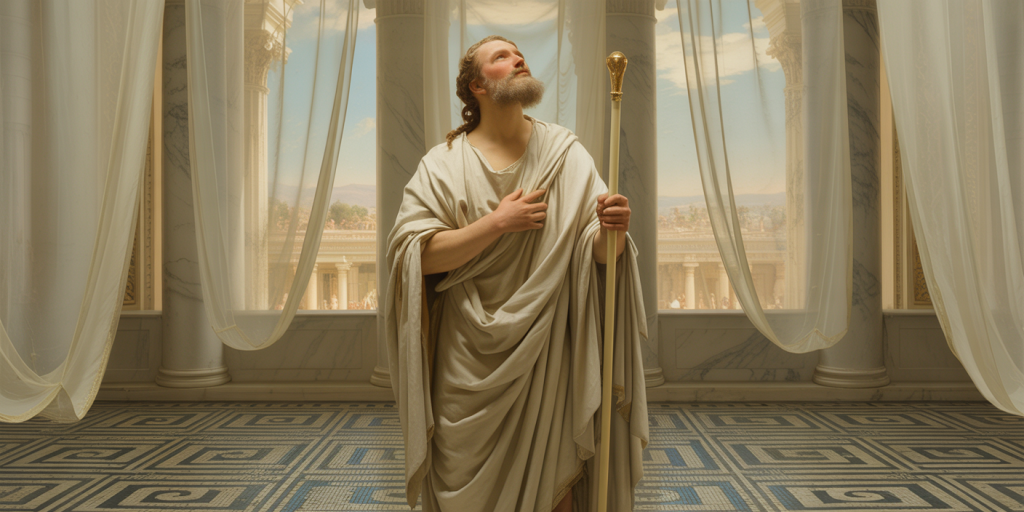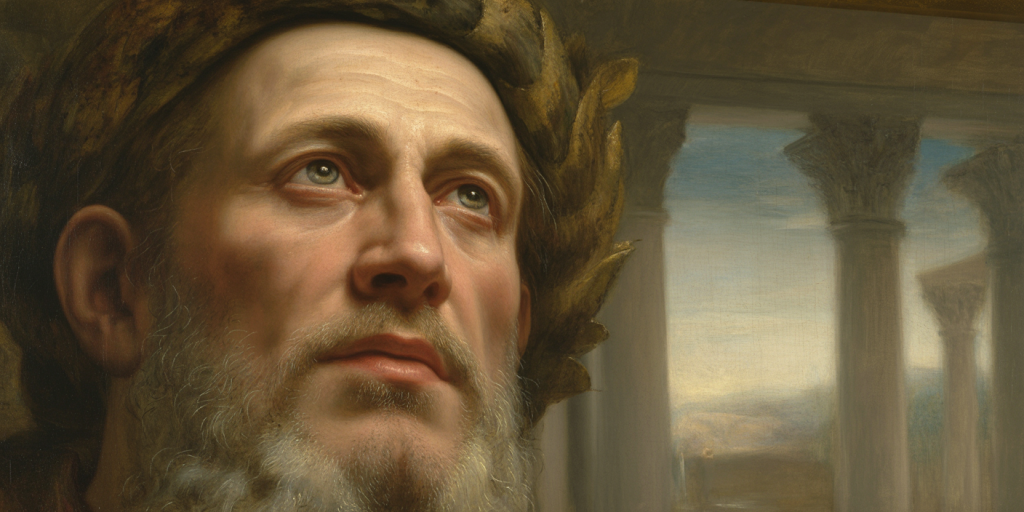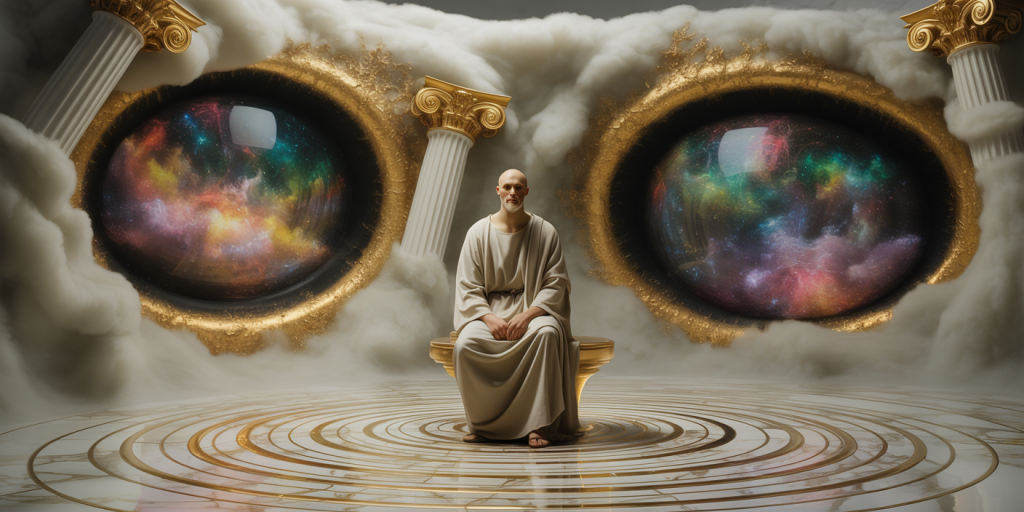Tiresias’ Blind Gaze in Alma-Tadema’s Brushes
A Contemplative Opening
In the crystalline stillness of a sun-drenched atrium, among marble colonnades and diaphanous silks fluttering like forgotten prayers, stands a man who does not see — and yet sees more than mortals ever will. His eyes are veiled not by darkness but by destiny. And though he looks nowhere, the gaze of Tiresias pierces time, silence, and myth.
In Lawrence Alma-Tadema’s imagined rendering — not drawn from any specific canvas, yet entirely true to his aesthetic — the blind seer is not just a figure of wisdom, but a figure of rupture. He exists where knowledge aches, where sight is not vision, and where prophecy hangs in the air like the scent of burning myrrh. The brushstrokes do not weep — they whisper. They shimmer with an elegance so polished it wounds.
Table of Contents
- Marble Dreams Beneath the Oracle’s Feet
- Curtains that Flutter like Fate
- The Geometry of Stillness
- Golden Light on Sightless Eyes
- A Face Carved from Forgotten Stone
- Mosaic of Omens
- Sandals of the Invisible Path
- Draperies that Sing in Silence
- The Echo of Prophecy in Flesh Tones
- The Cold Caress of Civilized Stone
- The Sky Reflected in a Blind Gaze
- The Architecture of Isolation
- The Olive Branch and the Veil
- A Voice That Paints the Future
- The Hand That Rests Upon Time
- A Seer Surrounded by Stillness
- Light Poured Like Honey Over Marble
- Between Sight and Silence
- The Blind Man as Mirror
Marble Dreams Beneath the Oracle’s Feet
Tiresias stands upon tiles as smooth as time itself — geometric tesserae of cream and dove-gray, glinting beneath his sandals like ripples caught in stone. Alma-Tadema’s mastery of architectural detail turns the floor into a language: cold, ordered, reverent. Every square beneath Tiresias becomes a whisper of fate.
The texture is almost tactile — polished and echoing — anchoring the scene in a realm that feels both imagined and archaeological. The artist’s obsession with classicism manifests not as imitation, but as invocation.
Curtains that Flutter like Fate
Behind the seer, thin curtains move as though stirred by something unseen — a wind not of this world but of prophecy. Their movement is subtle, nearly imperceptible, like thoughts brushing against a half-sleeping mind.
These translucent veils play with light and shadow, not merely as decoration but as thresholds. Alma-Tadema uses them to suggest the in-between — between knowledge and ignorance, between gods and men, between past and yet-to-come.
The Geometry of Stillness
Tiresias does not move. He need not. His body, draped in ivory robes, forms a perfect compositional anchor — vertical, unshaken, centered amid the scene’s luxurious serenity. The surrounding forms revolve around his presence like planets caught in prophetic orbit.
Alma-Tadema, master of control, orchestrates a stillness that breathes. The composition is almost musical in its arrangement — silent, yes, but vibrating.
Golden Light on Sightless Eyes
His eyes, though clouded, are bathed in a honey-golden light that falls from an unseen source above. This radiance caresses the face, not illuminating understanding, but sanctifying blindness.
There is no pity in how Alma-Tadema treats these eyes. Instead, there is reverence. The blindness becomes divine — a symbol of inner sight — a paradox at the core of Tiresias’s tragic clairvoyance.

A Face Carved from Forgotten Stone
Tiresias’s expression is solemn, yet not severe. His cheekbones are high and shadowed. His mouth, barely parted, seems on the verge of whispering some ancient truth. Alma-Tadema sculpts the face as if with a chisel — serene, timeless, unmarked by the world’s violence.
The skin is rendered with a delicacy that resembles ivory. There’s a smoothness to it, not youthful, but ageless. This is the face not of a man, but of myth.
Mosaic of Omens
In the background — on vases, panels, or wall frescoes — patterns emerge: laurel crowns, serpents entwined, a lyre abandoned in silence. These are visual footnotes, embroidered prophecies. Alma-Tadema does not scream symbols; he embeds them like archaeological clues.
Every mosaic tile becomes an omen — each glyph a riddle in stone. The viewer becomes not just an observer but a reader of visual scripture.
Sandals of the Invisible Path
Tiresias’s sandals are worn but elegant — practical yet noble. They evoke the dusty roads he’s walked through myth, bearing the weight of truths too heavy to utter. The leather glints with a whisper of travel and trial.
Alma-Tadema paints them not for realism but for resonance. They tether Tiresias to the human world, even as his soul stands elsewhere.
Draperies that Sing in Silence
The folds of the fabric around Tiresias’s form are drawn with exquisite care. They do not simply fall; they pause, flutter, cling. Each fold seems to react to a tension — emotional, not gravitational.
These draperies are not mere clothing; they are lyrical lines, moving with invisible breath. Their textures evoke parchment, water, cloud — timeless and weightless.
The Echo of Prophecy in Flesh Tones
Tiresias’s skin, though elderly, glows faintly — not with youth, but with the wisdom of endurance. Alma-Tadema shades it with warmth, but tempers it with chalky overtones — as though he were made of flesh and marble at once.
The effect is otherworldly. The flesh is alive, but nearly translucent — as if prophecy has thinned the boundary between body and spirit.
The Cold Caress of Civilized Stone
The setting is quintessentially Alma-Tadema: pristine marble benches, friezes of silent gods, the gentle hush of civility. But this refinement is not comforting — it isolates.
Tiresias is alone in a world of order, and that order heightens his strangeness. He is the wild truth in a cultivated cage.
The Sky Reflected in a Blind Gaze
Somewhere behind him, perhaps in the suggestion of an open atrium, the sky is rendered in barely-there pastel — a dusting of lapis, a hush of rose. But in his eyes, that sky finds no reflection.
This absence becomes poignant. The world may be beautiful, but Tiresias cannot behold it. And yet — he knows it more deeply than any who can.

The Architecture of Isolation
Columns rise behind him, creating a rhythm of vertical repetition — an architectural echo. This repetition enhances his isolation. Even surrounded by civilization, Tiresias is alone with the gods.
Alma-Tadema’s structures are not just settings — they are characters. These columns do not protect; they impose. They are the vertical bars of a visionary prison.
The Olive Branch and the Veil
At Tiresias’s side rests an olive branch, half-withered. It’s a quiet nod to Athena, to peace, to prophetic tradition. But a thin veil also drapes near his feet — white, almost unseen.
The juxtaposition is chilling: peace and veiling, wisdom and blindness. Alma-Tadema paints objects as metaphors — they shimmer quietly, but speak volumes.
A Voice That Paints the Future
Though mute in image, Tiresias speaks. One can almost hear the tone — low, slow, irrevocable. Alma-Tadema captures the weight of prophecy not through sound, but posture.
The slight tilt of the head, the parted lips, the gesture of a hand resting near the chest — all conspire to suggest speech that shapes fate.
The Hand That Rests Upon Time
One of his hands — weathered, sinewy — rests upon a scroll. The scroll itself is partially unrolled, revealing nothing readable. A gesture of restraint, or of warning?
The hand seems to pin down the very passage of time. Alma-Tadema paints it with reverence — this is no ordinary hand. It is the compass of chaos.
A Seer Surrounded by Stillness
Around him, time has stopped. There are no acolytes, no disciples, no dramatic gesture. Only stillness. This is not the seer as spectacle, but as stone.
Alma-Tadema understands the quiet gravity of myth. He lets the silence speak.
Light Poured Like Honey Over Marble
The light in the painting does not fall — it drips. It pools. It caresses every surface with gold too soft to hurt. Alma-Tadema’s mastery of atmospheric radiance is on full display.
Yet this light is not joyous. It is ceremonial. Tiresias glows like an offering — seen by the gods alone.
Between Sight and Silence
The painting exists in a liminal space — between vision and blindness, between action and repose, between knowing and not knowing. Tiresias is its axis.
Alma-Tadema is not illustrating a myth — he is distilling its essence into form, tone, and texture. The painting is not a scene; it is a state of being.

The Blind Man as Mirror
In Tiresias we see not ourselves, but what lies beneath us. He is not a mirror in which we recognize faces, but one in which we glimpse destinies.
Alma-Tadema uses him as a cipher — not just of myth, but of our own discomfort with truth. We look into his unseeing eyes and feel the weight of being seen.
FAQ
Was this painting ever made by Alma-Tadema?
No specific painting of Tiresias by Alma-Tadema is known, but this article imagines what such a work would be like, based on his consistent style, themes, and mythological leanings.
Who was Lawrence Alma-Tadema?
A 19th-century Dutch-born British painter known for his detailed depictions of classical antiquity, particularly Roman and Greek settings bathed in sensual light and architectural splendor.
What characterizes Alma-Tadema’s painting style?
Meticulous detail, luminous color palettes, precise architectural renderings, and a quiet, poetic stillness often inhabit his canvases. His work merges neoclassicism with Victorian romanticism.
Why Tiresias?
Tiresias, the blind prophet of Greek mythology, embodies contradiction: blind yet all-seeing, cursed yet wise. His complexity makes him an ideal figure for the lyrical and symbolic richness of Alma-Tadema’s imagined work.
What themes are evoked in this imagined painting?
Themes of destiny, isolation, spiritual perception, myth, and the fragility of human understanding flow through the imagined canvas, echoing broader questions about vision, knowledge, and silence.
Closing in Silence and Gold
If Alma-Tadema had painted Tiresias, the result would not have been a cry, but a hush. A hush so elegant it bruises. He would not have shouted prophecy from marble rooftops. He would have let the marble speak.
And in that imagined space of veiled sight, translucent light, and whispered omens, we too might learn — not to see, but to sense. To listen. To feel the echo of futures folded in the folds of silence. To become, for a fleeting moment, like Tiresias himself — blind not with absence, but with overwhelming presence.
